Accurate Analysis Method and Voltage Gain Curve Derivation Algorithm Based on Time-Domain Analysis for High-Efficiency LLC Resonant Converter Design
Abstract
:1. Introduction
2. TDA-Based LLC Resonant Converter Analysis Technique
2.1. Operation Mode Analysis of LLC Resonant Converter
2.2. Classification of LLC Resonant Converter Operation Modes
2.3. LLC Resonant Converter Operation Mode below Resonance
2.4. LLC Resonant Converter Operation Mode at Resonance
2.5. LLC Resonant Converter Operation Mode above Resonance
3. LLC Resonant Converter Analysis Algorithm
3.1. Operation Mode Determination Algorithm Considering Boundary Conditions
3.2. (Below Resonant Frequency Operation)
3.3. (Above Resonant Frequency Operation)
4. Operating Mode Boundary Search and Voltage Gain Curve Derivation Algorithm
5. Performance Verification
5.1. Comparison of the TDA Technique and Experimental Current Waveform
5.2. Derivation of LLC Operation Boundary Curve and Comparison of LLC Resonant Converter Voltage Gain Curve

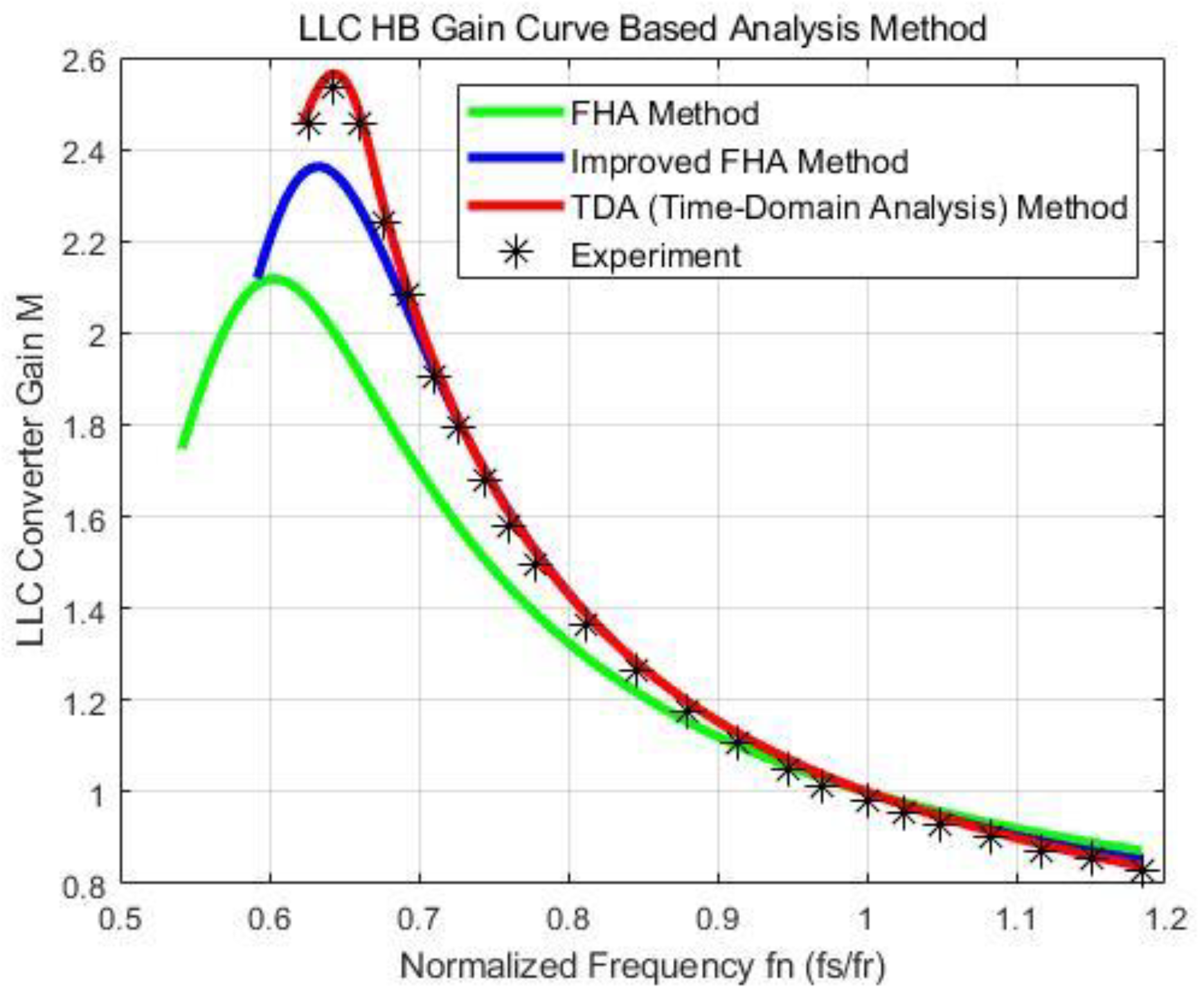

6. Conclusions
Author Contributions
Funding
Data Availability Statement
Conflicts of Interest
References
- Gu, Z.; Tang, J.; Zhu, W.; Yao, K.; Gao, Z.; Shi, W.; Zhang, Z.; Ren, X. Comparison of wide-bandgap devices in 1 kV, 3 kW LLC converters. Chin. J. Elect. Eng. 2020, 6, 65–72. [Google Scholar] [CrossRef]
- Fang, X.; Hu, H.; Chen, F.; Somani, U.; Auadisian, E.; Shen, J.; Batarseh, I. Efficiency-oriented optimal design of the LLC resonant converter based on peak gain placement. IEEE Trans. Power Electron. 2012, 28, 2285–2296. [Google Scholar] [CrossRef]
- Choi, S.Y.; Kim, R.Y. Power Loss Analysis of Full-Bridge LLC Resonant Converter. In Proceedings of the 2021 24th International Conference on Electrical Machines and Systems (ICEMS), Gyeongju, Republic of Korea, 31 October–3 November 2021; IEEE: Manhattan, NY, USA, 2021; pp. 179–182. [Google Scholar]
- Yang, C.H.; Liang, T.J.; Chen, K.H.; Li, J.S.; Lee, J.S. Loss Analysis of Half-Bridge LLC Resonant Converter. In Proceedings of the 2013 1st International Future Energy Electronics Conference (IFEEC), Tainan, Taiwan, 3–6 November 2013; IEEE: Manhattan, NY, USA, 2013; pp. 155–160. [Google Scholar]
- Yang, B.; Lee, F.C.; Zhang, A.J.; Huang, G. LLC Resonant Converter for Front End DC/DC Conversion. In Proceedings of the Annual IEEE Conference on Applied Power Electronics Conference and Exposition (APEC), Dallas, TX, USA, 10–14 March 2002; Volume 2, pp. 1108–1112. [Google Scholar]
- Wei, Y.; Luo, Q.; Chen, S.; Sun, P.; Altin, N. Comparison among different analysis methodologies for LLC resonant converter. IET Power Electron. 2019, 12, 2236–2244. [Google Scholar] [CrossRef]
- Ivensky, G.; Bronshtein, S.; Abramovitz, A. Approximate analysis of resonant LLC DC-DC converter. IEEE Trans. Power Electron. 2011, 26, 3274–3284. [Google Scholar] [CrossRef]
- Liu, J.; Zhang, J.; Zheng, T.Q.; Yang, J. A modified gain model and the corresponding design method for an LLC resonant converter. IEEE Trans. Power Electron. 2016, 32, 6716–6727. [Google Scholar] [CrossRef]
- Glitz, E.S.; Ordonez, M. MOSFET Power Loss Estimation in LLC Resonant Converters: Time Interval Analysis. IEEE Trans. Power Electron. 2019, 34, 11964–11980. [Google Scholar] [CrossRef]
- Fang, X. Analysis and Design Optimization of Resonant DC-DC Converters. Ph.D. Thesis, University of Central Florida Orlando, Orlando, FL, USA, 2012. [Google Scholar]
- McLyman, W.T. Transformer and Inductor Design Handbook; Marcel Dekker: New York, NY, USA, 2004. [Google Scholar]
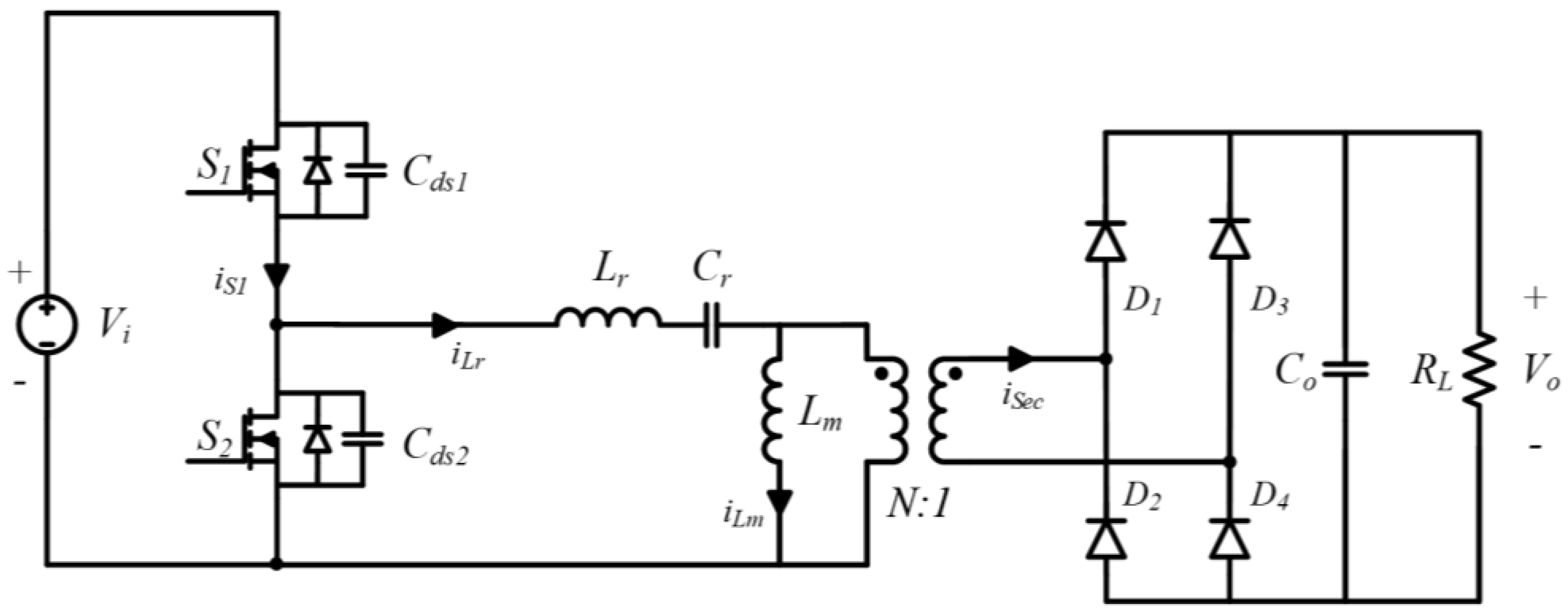


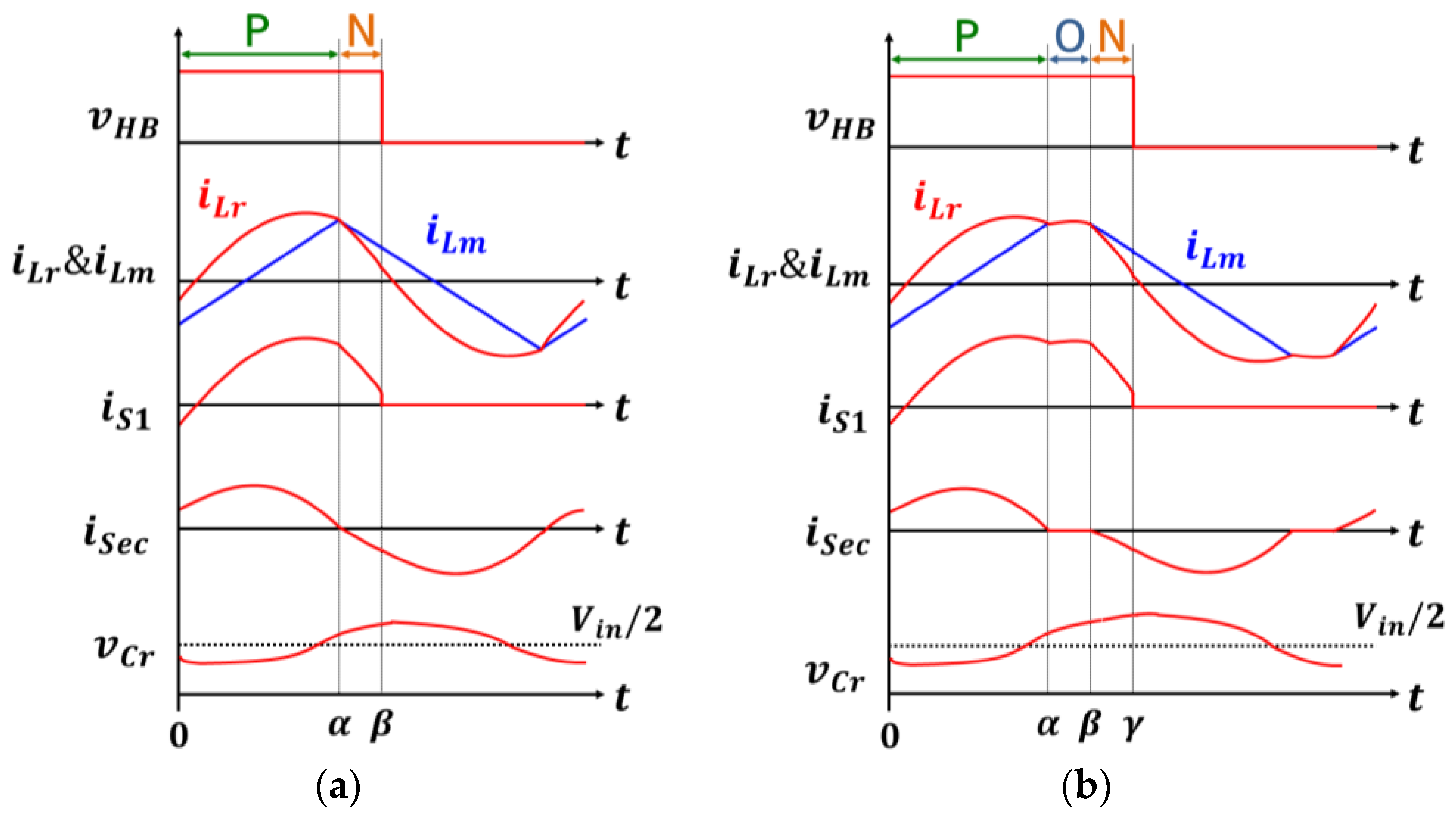
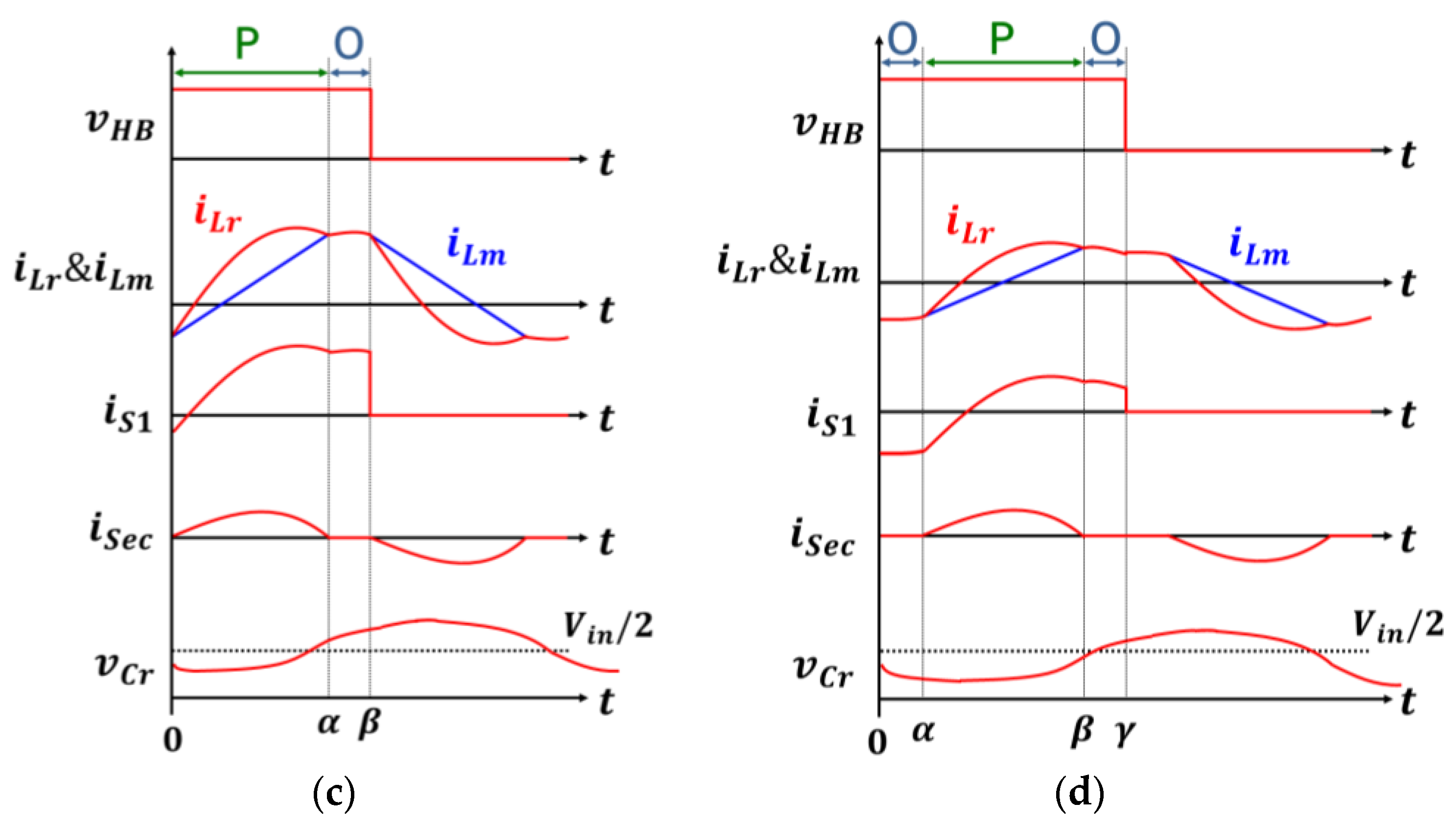

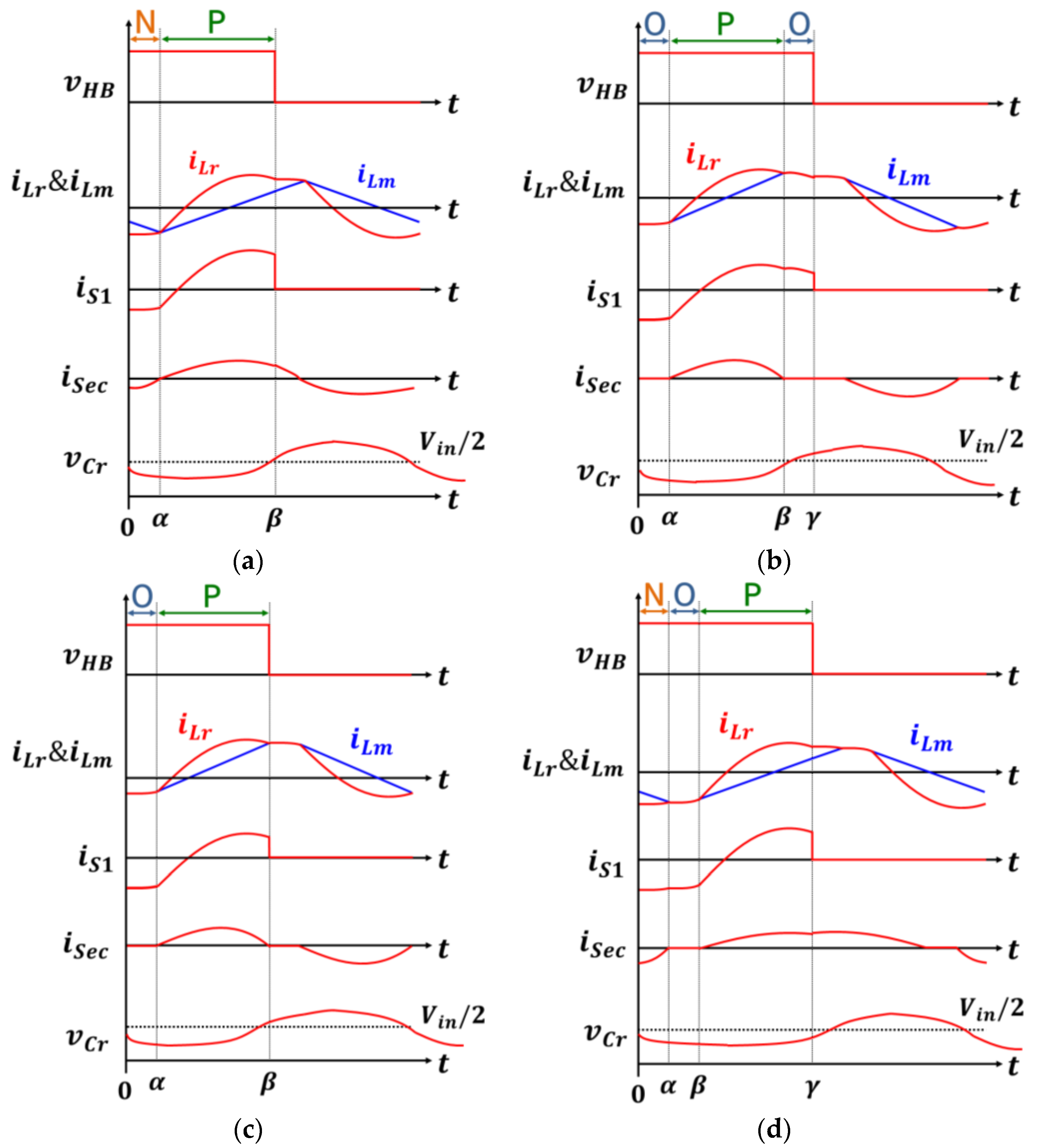
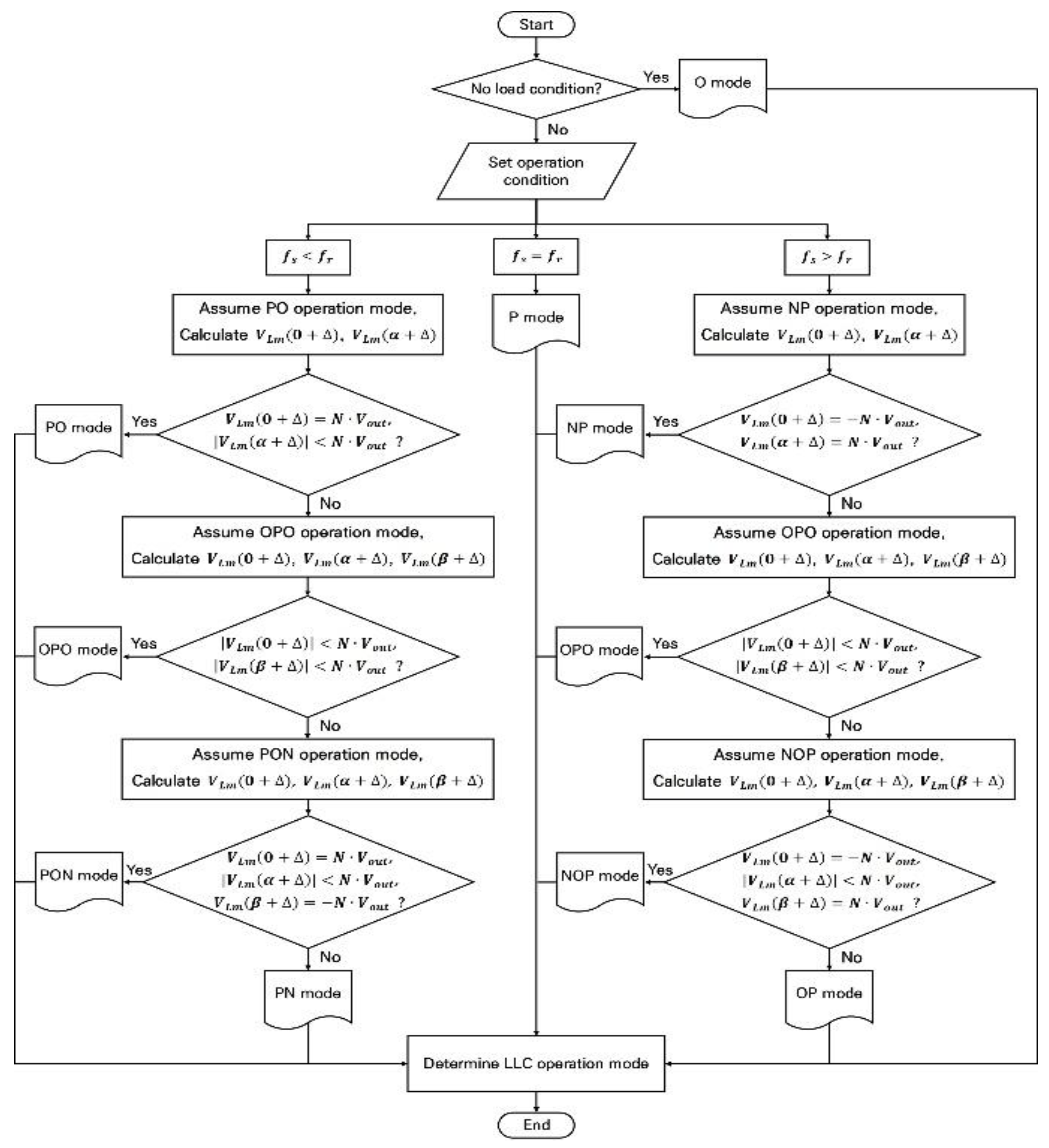

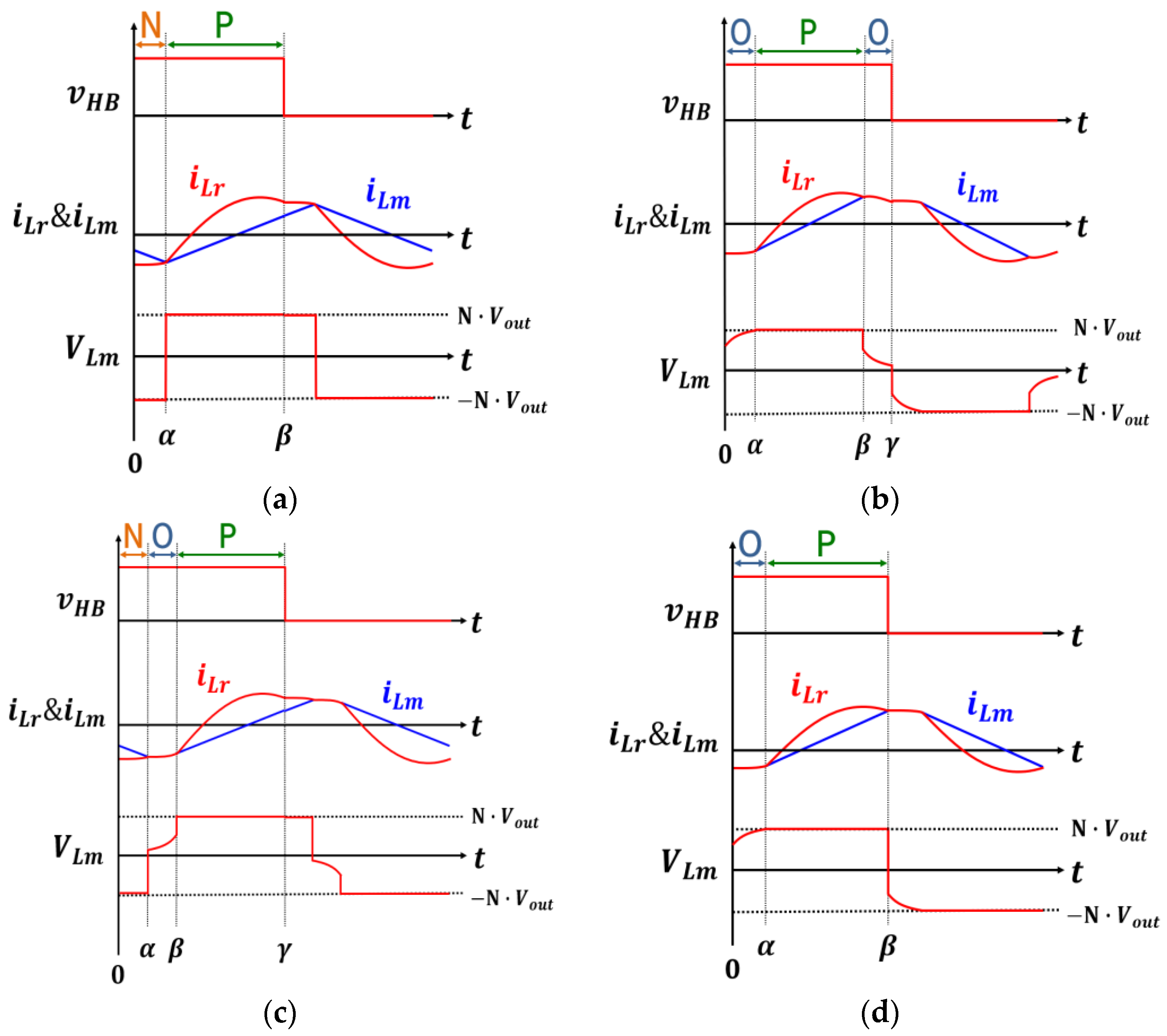



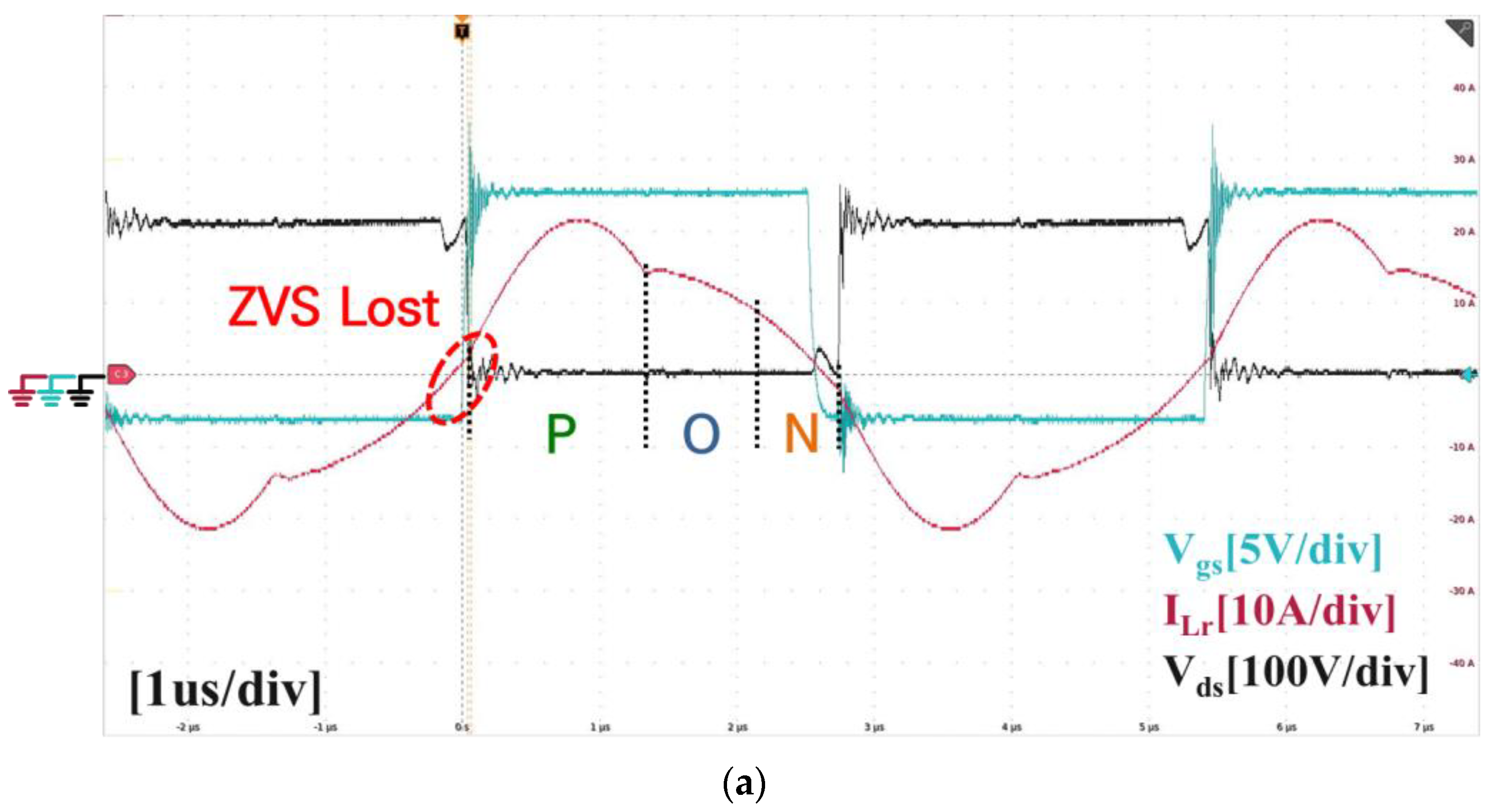
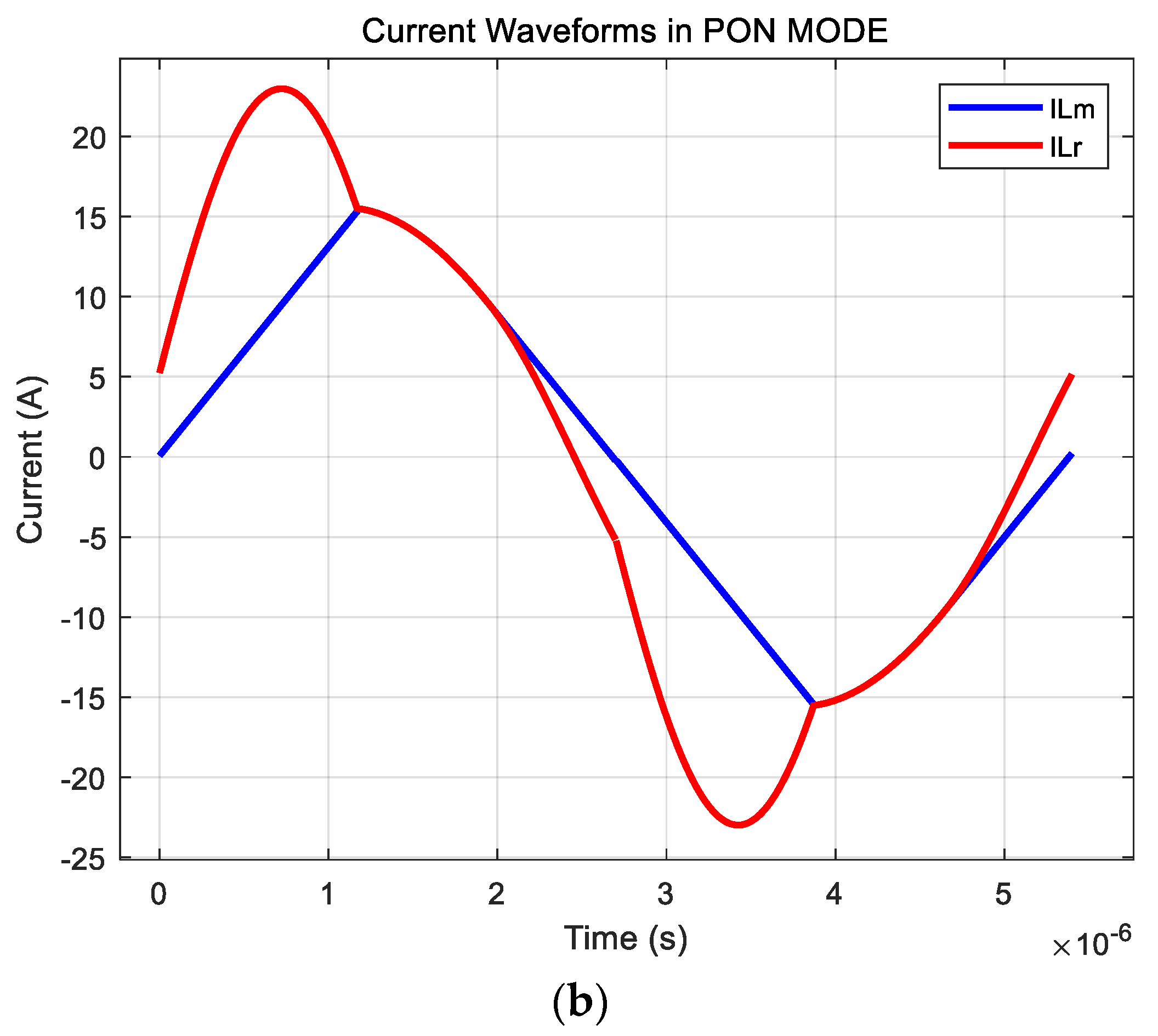

| Symbol | Quantity | Value (Unit) |
|---|---|---|
| Input voltage | 210 (V) | |
| Rated output power | 500 (W) | |
| Resonant inductor | 9.4 (μH) | |
| Resonant capacitor | 30 (nF) | |
| Magnetizing inductance | 20 (μH) | |
| Transformer turn | 1.5 | |
| Resonant frequency | 300 (kHz) | |
| Switching frequency | 185–350 (kHz) |
| Switching Frequency | Value | TDA Method | Experiment | Error |
|---|---|---|---|---|
| 185 kHz | 5.1 A | 5.2 A | 2 % | |
| 21.6 A | 22.2 A | 2 % | ||
| 14.1 A | 14.5 A | 2 % | ||
| 300 kHz | −4.2 A | −4.4 A | 4 % | |
| 5.3 A | 5.5 A | 3 % | ||
| 3.9 A | 4 A | 2 % | ||
| 330 kHz | −4.3 A | −4.5 A | 4 % | |
| 4.7 A | 4.8 A | 2 % | ||
| 3.2 A | 3.3 A | 3 % |
Disclaimer/Publisher’s Note: The statements, opinions and data contained in all publications are solely those of the individual author(s) and contributor(s) and not of MDPI and/or the editor(s). MDPI and/or the editor(s) disclaim responsibility for any injury to people or property resulting from any ideas, methods, instructions or products referred to in the content. |
© 2023 by the authors. Licensee MDPI, Basel, Switzerland. This article is an open access article distributed under the terms and conditions of the Creative Commons Attribution (CC BY) license (https://creativecommons.org/licenses/by/4.0/).
Share and Cite
Park, S.-S.; Eom, M.-H.; Lee, S.-T.; Kim, R.-Y. Accurate Analysis Method and Voltage Gain Curve Derivation Algorithm Based on Time-Domain Analysis for High-Efficiency LLC Resonant Converter Design. Electronics 2023, 12, 2030. https://doi.org/10.3390/electronics12092030
Park S-S, Eom M-H, Lee S-T, Kim R-Y. Accurate Analysis Method and Voltage Gain Curve Derivation Algorithm Based on Time-Domain Analysis for High-Efficiency LLC Resonant Converter Design. Electronics. 2023; 12(9):2030. https://doi.org/10.3390/electronics12092030
Chicago/Turabian StylePark, Su-Seong, Min-Ho Eom, Sang-Taek Lee, and Rae-Young Kim. 2023. "Accurate Analysis Method and Voltage Gain Curve Derivation Algorithm Based on Time-Domain Analysis for High-Efficiency LLC Resonant Converter Design" Electronics 12, no. 9: 2030. https://doi.org/10.3390/electronics12092030
APA StylePark, S.-S., Eom, M.-H., Lee, S.-T., & Kim, R.-Y. (2023). Accurate Analysis Method and Voltage Gain Curve Derivation Algorithm Based on Time-Domain Analysis for High-Efficiency LLC Resonant Converter Design. Electronics, 12(9), 2030. https://doi.org/10.3390/electronics12092030







